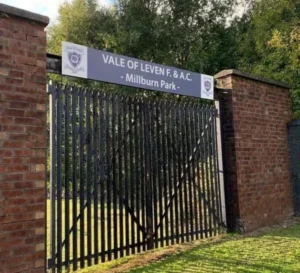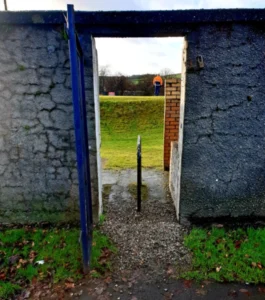
As part of my role as Scottish correspondent for Groundtastic magazine I wrote a number of club articles dedicated to a particular stadium. I hugely enjoyed visiting new towns and cities to unearth some architectural gems of the football world. As a roving reporter I visited Tynecastle, Firs Park, Caledonian Stadium, Victoria Park, Borough Briggs, and completed a tour of the football grounds of the Highland League to name but a few.
I have recently been watching the vlogs of Footy Adventures, which I would heartily recommend to those of you who are interested in football stadiums and architecture. These vlogs are exactly the sort of thing that I would have been producing if things were different. Sadly, I have been held back by a progressive, genetic disease of the nervous system, the related disability, a lack of technical expertise to produce videos and being in Scotland at the wrong time, with the wrong person.
I suppose what I have done as an alternative is to write Every Silver Lining has a Cloud, which is an autobiographical tour of the Welsh Premier League football grounds. For those who have yet to read it – shame on you. I am happy with my own contribution to the world of football architecture, but I can’t help having feelings of envy and jealousy as I watch the ever increasing body of vlogs produced by Footy Adventures.
I have decided to reproduce the club articles and photographs that I managed to take during my time in Scotland. This was a difficult time for myself as I was beginning to feel the full effects of living with Friedreich’s Ataxia. It would obviously difficult having to rely on trains to get me to my desired destination and the fact that I was losing my dexterity meant that it was increasingly difficult to take decent photographs.
I have been unable to locate some of the photographs that I took while in Scotland. Should you need proof, then you only have to find a copy of Groundtastic to see that I have been credited for taking some photos. For the purposes of this blog about Millburn Park, I have had to utilise photographs that I have found on the internet. These photos are of a high standard, and I do not claim to have produced these myself. Where possible, I have included links to the original pages where I found these photos.
With regards to my trip to the home of Vale of Leven, I remember that I had made arrangements to meet someone from the club to show me around the famous old stadium. Unfortunately, the person in question never turned up, and I had to take pictures from the outside of the ground. This limited the quality of photos that I could take, but for some reason I didn’t walk right around the ground. I simply hung around the main gates, but from these pictures published below, it seems that I could have got many more photos from different vantage points on the other side of Millburn Park. It was an unsatisfying way to spend a Sunday morning.
Overall, I am happy with what I wrote, and hope the following is of interest to some of you.
***

Ten teams competed in the first Scottish League campaign back in 1890-91: eventual champions Dumbarton (Boghead Park), Rangers (Ibrox I), Celtic (Celtic Park), Cambuslang (Whitefield Park), 3rd L.R.V (Cathkin Park), Hearts (Tynecastle), Abercorn (Underwood Park), St Mirren (Westmarch), Vale of Leven (Millburn Park) and Cowlairs (Gourlay Park). Of the ten venues used in the new league competition, only two survive and regularly host competitive football – Tynecastle and Millburn Park. As is outlined in Scots Scene, Hearts are about to kick off their final season at Tynecastle, which will leave Vale of Leven’s Millburn Park as the only surviving ground used during the first season of Scottish League football. Nowadays, Vale play Junior football in Central League Division One but their historic ground, which was once compared to Hampden and Ibrox I, is falling apart around them…
The Vale of Leven lies 20 miles north-west of Glasgow and consists of five Dunbartonshire districts – Alexandria, Balloch, Jamestown, Renton and Bonhill – but home for the Vale’s footballers has always been Alexandria. Cameron’s Park, Doctor’s Loan (1872-73) and North Street Park (1873-88) were used during the club’s halcyon days but on May 25 1888 work began on a new ground at the South end of Alexandria.
According to a report in the Scottish Umpire newspaper, construction of the new venue cost £700, which included the re-erection of the North Street pavilion and grandstand. The pitch measured 120 yards by 75, encircled by a 15 feet wide cinder track, which broadened to 20 feet on the North side. The ground was christened Millburn Park after the nearby Millburn Quarry. A large mill in the quarry discharged water, the overflow of which ran down the burn and ended up in the Leven, near Turnbull’s or Trummel’s Loan. This area, including the ground, was owned by Mr Turnbull and became known as Millburn.
The following extract, from the Scottish Umpire, suggests the finished ground was well-received:
“The Vale of Leven committee have made a splendid virtue of a rude necessity in preparing such a handsome, compact, well-furnished ground; and Millburn Park will hereafter be bracketed with Hampden and Ibrox in point of comfort and finish, although it has not the capacity of either… At a distance you are reminded of Ibrox Park. It lies perfectly flat, and is enclosed with the same corrugated iron which is so distinguishing a feature of the Rangers ground. The enclosure is oblong in shape, closely following the shape of the quarter mile track which surrounds the well-laid 120 by 70 pitch. The stand and club house – the self-same that adorned the discarded ground, although wonderfully improved by contact with the painters brush – is on your left on entering… The pitch is in wonderful condition for it’s age, a remark which also applies to all within the vast enclosure. The track is at yet only in the rough, but when finished and banked will be at least equal to any in Scotland – 16 ft wide with a 27ft wide finish.”
However, the success that Vale had enjoyed in the 1870’s was now only a distant memory and a steep decline was about to begin – not helped by the crippling financial costs involved in the move to their new ground. Poor attendances and the legislation of professional football further hindered their chances of survival. Only two seasons were spent in the Scottish League (1890-1892) before they were forced to resign their membership and the Millburn Park albatross finally squeezed the life out of them in 1894. The subsequent years saw several attempts to reform and restructure but although they regained Scottish League membership they never returned to the top flight and lay dormant between 1928-29 and 1938-39 with the exception of occasional friendlies and cup matches. It was at the beginning of the 1939-40 season that Vale of Leven reappeared in it’s current guise as a Football and Athletic Club and Millburn Park has staged Junior football ever since.

Unfortunately, through Vale’s troubled history Millburn Park has been neglected. A historical structure that should have been embraced, cherished and celebrated is now nothing more than a dilapidated ruin haunted by ghosts of the past. That the ground has suffered from the passage of time is obvious from the tired exterior. The corrugated iron enclosure fencing is rusted and is crying out for a lick of paint but – as Dave Twiddle asks in Volume 3 of his Rejected of Scotland series – is it too fanciful to consider this as the original? To the right of the main entrance you can also see where the old turnstiles have been concreted over in a rudimentary manner with no thought of preservation.
This venue – which once held over 10,000 for a Scottish Cup replay against Clydebank in the mid-1960’s – is now limited to a capacity of 2,000. It is standing room only for the average 125 fans that turn up to watch their amateur heroes in action while shelter is limited to one of the two decaying terraced sections. The barrel shaped roof appears to be constructed from corrugated iron but this is missing from the similar skeleton structure that sits beside it.

Opposite this sits the barbed wire covered pavilion that was opened in 1983. The occasion was marked with a challenge match against Celtic after vandals celebrating Guy Fawkes Night in 1981 burned the original structure to the ground. Eleven single poles that hold one – sometimes two – lamps act as uninspiring floodlights.
As for the future? The ground is now owned by the Millburn Trust who hopefully have a historical appreciation of the park although there are no plans as yet for any improvements or restoration. Let us hope action is taken sooner rather than later. For more information on Vale of Leven go to www.valeoflevenfc.co.uk

***
Although not played at Millburn Park, Vale of Leven was also involved in the first match in Scotland played under floodlights. On October 25 1878, Vale met Third Lanark R.V at Cathkin Park in an ‘electric light match’ but the experiment failed to impress, as the following extract from the Glasgow News illustrates:
“The arrangements…were by no means suitable for the prosecution of a skilful game of football…Only one light was employed, and the result was that a third of the field was always in total darkness.”
A reflector intended to spread the light failed to arrive from the continent in time for the match and a less effective one had to be used. Further experiments took place over the next couple of years but it was not until the 1950’s that floodlights gained belated success.

Millburn Park Facts
First Game: 2-2 v Dumbarton, August 18, 1888
Record Attendance: 10,000+ v Clydebank, mid-1960’s, Scottish Cup replay
Current Capacity: 2,000

Vale of Leven
Founded: August 20, 1872
Reformed: 1896
Folded: 1939
Reformed: 1939 (As Junior club).
Honours: Scottish Cup Winners: 1877, 1878, 1879
***
Twenty odd years after I had written the Groundtastic article on Millburn Park, a YouTube vlogger produced the following video as part of his tour around Scottish football grounds. Check out the impressive array of football ground vlogs produced by Footy Adventures by clicking here.

